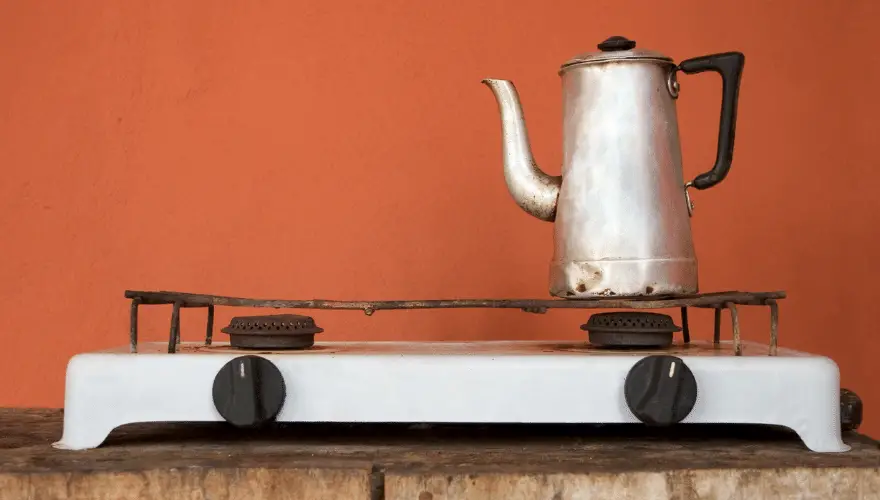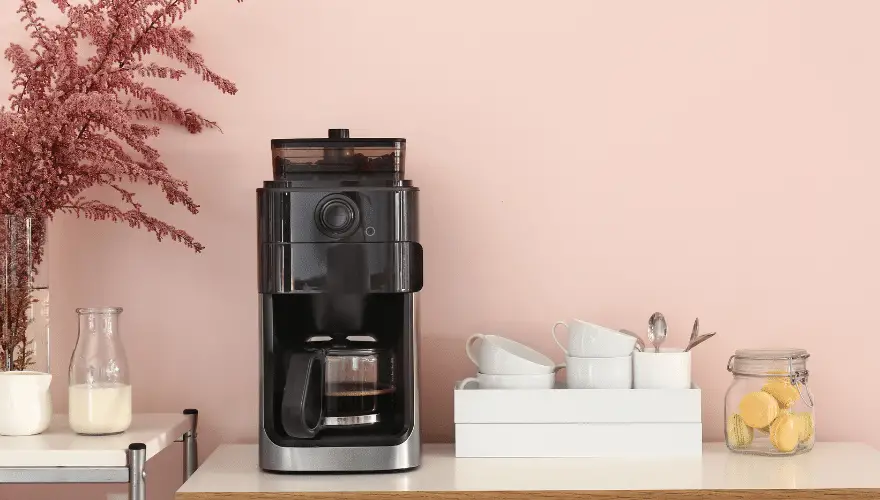How often do you get busy in front of the computer and totally forget about the lonely cup of coffee sitting on your desk? If you’re like me, it happens all the time. You’re on a deadline and don’t have time to make a fresh pot. Or you simply forget about it.
Your go-to solution might be the microwave or the stovetop. But, have you ever asked yourself how to reheat coffee properly? Is there such a thing as the “best way to reheat coffee”? Yes, there is! But only if you know how to reheat it properly.
This article explains the 3 methods for reheating coffee and that best method that will retain as much flavor and aroma as possible.
Can you Reheat Your Coffee?
The short answer is yes, you can. As long as you reheat it slowly. But there is more to it than just haphazardly reheating. Read on to discover more.
How to Reheat Your Coffee
We’ll go through the various ways to reheat your coffee below. However, it’s best not to reheat coffee if you want the full flavors and aromas of a fresh brew. But, if you have no other choice, reheating coffee without destroying the flavor is possible.
How to Heat up Coffee in a Coffee Maker
This is the least likely method to actually get your coffee warm enough, as the heating plate doesn’t reach a high enough temperature. On top of that, it may still burn your coffee because of the time it will take to warm.
How to Warm up Coffee on the Stovetop

Warming your coffee on the stovetop is the best method to avoid altering the taste too much. The reason for this is that you have better control over the heating process. You should warm it slowly, but not too slowly.
If you live in a place that goes through regular power load-shedding cycles, you’ll know all too well that a gas stove—fitted or portable—is the only way to have a hot cup of joe.
On a gas stove you use around 20% of its power and with an electric one, around 30%. If the coffee bubbles, you’ve overdone it, and it will probably burn. But heating it until steam just starts rising is probably okay.
How to Reheat Coffee in the Microwave

While reheating coffee in your microwave may not be ideal, it’s not the worst method. Especially if you’ve tried reheating your coffee in a coffee maker or on the stovetop and burned it. Yuck!!! Reheating coffee in the microwave is the fastest way to get your coffee warm enough to drink.
Ceramic mugs are great for reheating your coffee, but be careful not to burn your hand when removing it. Not all ceramic is microwave-safe [1] (who knew?!), so be sure to check yours. If yours are, great news! They retain heat better than other materials and will keep your reheated coffee hot for longer.
Setting Your Microwave to the Correct Temperature
Many articles will advise you to set the microwave to level 8 for reheating coffee, but this depends on the wattage of your microwave oven. Most range between 600 and 1200 watts, though they can go up to 2100 watts. So, level 8 (or 80% power) on one appliance may not have the same output as level 8 on another. If you’re not sure what your microwave’s wattage is, set it to 100% power, then place a cup of cold water on the center plate. If the water boils in:
- 1 1/2 minutes, it’s1200 watts
- 2 minutes, it’s 1,000 watts
- 2 1/2 minutes, it’s 800 watts
- 3 minutes, it’s 700 watts
- 4 minutes, it’s 600 watts
Of course, for that perfect cup of reheated coffee, boiling it will make your coffee taste unpalatable. So, to get it hot enough without spoiling the flavor:
- Set your microwave to level:
- 10 (or max) on an 800-watt microwave
- 9 on a 900-watt microwave
- 8 on a 1,000-watt microwave
- 7 on a 1,200-watt microwave
- Heat for approximately:
- 45 seconds from cold
- 30 seconds from lukewarm
- If your coffee is still not warm enough, then increase the heating process in increments of 10–20 seconds at a time.
Will the Flavor be Ruined?
Well, that’s up to you really. While there are those who are quite happy with their burned coffee (I mean, better that than throwing it out, right?), many would rather toss the contents down the drain than drink it.
How the Brewing Process Brings Out the Aromas and Flavors
While the roasting process generates the smell and scent of coffee, it seems stronger after it’s been brewed. That’s because the hot water draws out the soluble compounds from the grounds. These compounds quickly evaporate and drift through the air, and we smell that familiar coffee aroma.
Coffee Beans Contain Chlorogenic Acids and Quinic and Caffeic Acids
Chlorogenic acids are a class of phenolic acids and an abundance of them are found in coffee beans. These help with glucose regulation [2], as well as having other health benefits, including liver protection [3].
Of all coffee beans (green, light roast, or dark roast), unroasted coffee contain the highest amount of chlorogenic acids and the least amount of quinic and caffeic acids. The roasting process then breaks down the chlorogenic acids into quinic and caffeic acids. These have a slightly sweeter and more acidic taste.
Chemical Changes Occur When Coffee Beans are Roasted
Coffee beans, when picked, are greenish in color—at least after the skin and mucilage have been removed. The roasting process not only dries the beans but causes major chemical changes to occur. Almost one-third of the over 800 compounds raised are aromatic in nature. [4]
Although normal roasting methods do not eradicate the chlorogenic acids, one study showed that roasting at high temperatures (480 degrees Fahrenheit) reduces it to almost trace levels [5]. There’s also a correlation between total caffeoylquinic acids (quinic and caffeic acids) and pH levels.
Reheating Changes the Flavors
When you brew a cup of coffee, there are often fine particles that don’t fully dissolve, especially if you’ve used a French press. During reheating, these particles become more volatile, and therefore, the overall bitterness of your coffee may increase. Also, these particles often get burned during the reheating process.
The effect on the taste of your coffee is…well…yuck! And you end up pouring it down the drain, anyway.
Does That Include Both Freshly-ground And Pre-ground Coffee?
Yes, it includes both, though many argue (myself included) that you should never use pre-ground coffee.
While all coffee has an element of bitterness to it, its tastes do differ. One person could be a slave to a cup of light roast and the next can’t stomach it and will opt for the more bitter, dark roast. But either way, most of us can taste whether the coffee is fresh or not.
With freshly ground coffee, the consensus is that it must be brewed within 30 minutes of grinding to maintain its optimal flavors. With pre-ground coffee, we don’t have that luxury. Since the packages are vacuum sealed, they’re fresh when opened. But exposure to air quickly stales the coffee.
This affects fine grounds more quickly than course grounds since a larger surface area is exposed to air in the case of fine grounds.
What Keeps Enticing Us to That Cup of Coffee?
There’s a scientific reason that coffee smells so good [6]. Multiple compounds are responsible. But furfurylthiol, a combination of sulfurs that smell pretty bad on their own, is known as the “coffee smell.” This is true for all of the different roasts.
If you enjoy light roast coffees more, then maybe you enjoy the less acidic variety. If you’re drawn to the dark roast coffees, then perhaps it’s the increased phenylindanes that you’re noticing. Either way, no one can deny that the smell of coffee keeps us coming back and again and again.
How to Keep Coffee Hot
There are many ways to keep your coffee hot without having to reheat it. But if you’re like me, I don’t go anywhere without my trusty thermos travel mug. Still, it’s never quite the right temperature.
Either it’s way too hot and before you know it, you’ve burnt your lips. Or worse still, when the scalding liquid is too hot for your mouth, you swallow instead. Then the gulp scorches its way down your gullet.
Or, if you’ve left the coffee for too long, it’s lost its initial warmth—that just-right temperature we crave. Because let’s face it, the temperature of your coffee is almost synonymous with how much you enjoy that cup.
Another way is to leave it in the coffee maker. But that has to be the worst idea ever—unless you particularly enjoy the smack of burned coffee.
Related Articles:
- Can you heat cold brew coffee?
- 10 Ways To Keep Coffee Hot: Brilliant And Cheap Methods
- How Hot Should Coffee Be Served?
Conclusion
It’s always best to drink your coffee while it’s fresh and hot. But that’s not always possible. We forget, get distracted, or other priorities take us away from our favorite brew. How do you warm it up without destroying the flavor?
First, you can use a microwave, which is undoubtedly the quickest method. But don’t overheat your coffee. This will definitely spoil the flavor!
No microwave? How to reheat coffee without a microwave? Use either a coffee maker with a warming plate (although we don’t recommend this method) or the stovetop.
But the very best way to reheat coffee, without spoiling the flavor or making it too hot, is to use the stovetop.
References:
- https://www.thecommonscafe.com/are-coffee-mugs-microwave-safe-an-overview-of-different-types-and-tips-for-ensuring-safety/
- https://www.sciencedirect.com/science/article/pii/B9780124095175000863
- https://www.sciencedirect.com/science/article/pii/B9780124095175000681
- https://www.coffeechemistry.com/chemical-changes-during-roasting
- https://www.researchgate.net/publication/26296017_Role_of_Roasting_Conditions_in_the_Level_of_Chlorogenic_Acid_Content_in_Coffee_Beans_Correlation_with_Coffee_Acidity



